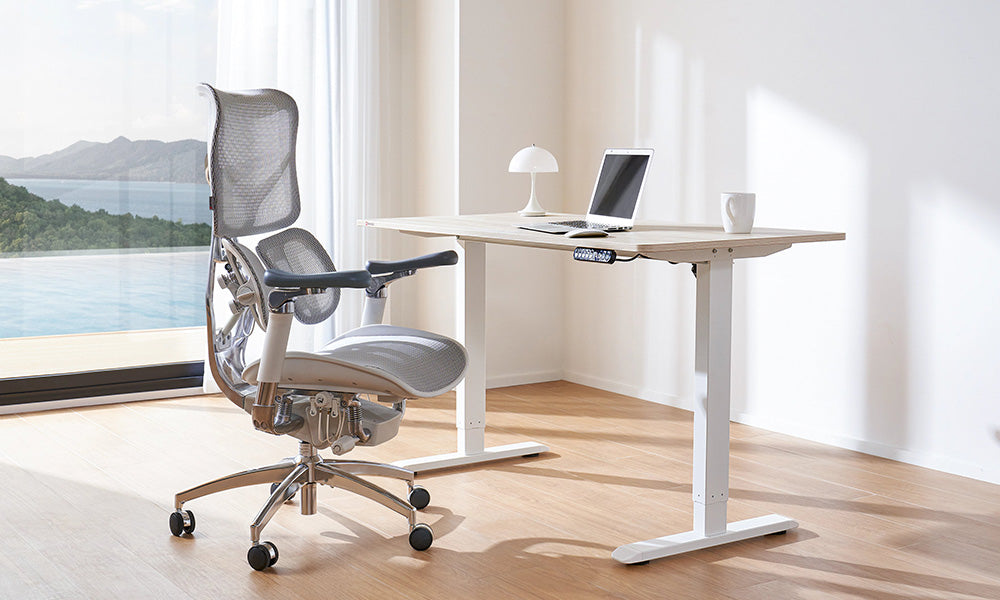The modern workplace is often synonymous with long hours spent glued to a chair. While comfort might seem paramount, research suggests that prolonged sitting can have detrimental effects on our health and well-being. This is where standing desks have emerged as a popular alternative, offering a way to break free from the sedentary rut and potentially boost productivity.
This guide delves into everything you need to know about incorporating a standing desk into your workday. From understanding the potential benefits to practical tips for setting up your workstation and creating a sustainable routine, we'll equip you to make an informed decision and optimize your work experience.
Benefits of a Standing Desk:
Improved Physical Health: Standing desks can help combat the negative consequences of prolonged sitting, such as increased risk of obesity, heart disease, and type 2 diabetes.
Enhanced Energy Levels: Studies suggest standing can improve blood flow and circulation, leading to increased energy and reduced fatigue.
Boosted Productivity: Some research indicates that standing desks can lead to increased focus and concentration, potentially leading to higher productivity.
Improved Posture: Standing desks encourage better posture, which can alleviate back pain and discomfort.
Reduced Back Pain: By keeping your core engaged and distributing your weight more evenly, standing desks can help reduce lower back pain associated with prolonged sitting.
Before You Begin: Considerations for Standing Desks
While standing desks offer a range of potential benefits, it's important to consider a few factors before taking the plunge:
Individual Needs: Consult your doctor if you have any pre-existing health conditions, especially lower body or joint issues. They can advise you on whether a standing desk is suitable for you.
Workstyle: If your job requires tasks that necessitate sitting for extended periods, a standing desk might not be ideal.
Cost: Standing desks, especially adjustable models, can be an investment. Consider your budget and weigh the potential benefits against the cost.
Setting Up Your Standing Desk Workstation:
Creating an ergonomically sound workstation is crucial for maximizing the benefits of a standing desk and minimizing discomfort. Here's what you need to consider:
Desk Height: The ideal desk height allows your elbows to bend at a 90-degree angle when your arms are relaxed by your sides. Adjustable desks offer the most flexibility.
Monitor Position: The top of your monitor should be at or slightly below eye level to maintain proper neck posture. Utilize a monitor arm to adjust the height and position for optimal viewing.
Antifatigue Mat: Standing for extended periods can put strain on your feet and legs. An anti-fatigue mat provides cushioning and promotes subtle movement to improve circulation and comfort.
Supportive Footwear: Opt for comfortable shoes with good arch support to minimize foot and ankle strain.
Creating a Sustainable Standing Desk Routine:
Start Slowly: Don't jump straight into full-time standing. Begin with short intervals (15-30 minutes) throughout the day, gradually increasing the duration as your body adapts.
Alternate Between Sitting and Standing: Aim for a balanced approach. Listen to your body and take breaks to sit down when needed.
Move Throughout the Day: Incorporate short stretches or light walking breaks throughout your workday, even while standing, to promote blood flow and prevent muscle fatigue.
Hydration is Key: Staying hydrated becomes even more important when standing for longer periods. Keep a water bottle on your desk and sip regularly.
Strengthen Your Core: Strong core muscles are essential for maintaining good posture while standing. Consider core-strengthening exercises to support your back and improve endurance.
Additional Tips for Success:
Invest in a Comfortable Chair: Even with a standing desk, you'll still need a comfortable chair for breaks and tasks requiring sitting.
Organize Your Workspace: Keep frequently used items within easy reach while standing to minimize unnecessary movement.
Consider a Standing Desk Converter: If a full standing desk isn't feasible, a standing desk converter can be placed on your existing desk to create a temporary standing surface.
Stay Motivated: Track your progress and celebrate milestones to maintain motivation. Partnering with colleagues who also use standing desks can provide encouragement and support.
Conclusion
While standing desks aren't a magic bullet for health and productivity, they offer a valuable tool to combat the downsides of a sedentary work style. By carefully considering your needs, setting up your workstation ergonomically, and gradually incorporating standing into your routine, you can maximize the benefits of a standing desk and create a more comfortable and productive work environment.






Laisser un commentaire
Ce site est protégé par hCaptcha, et la Politique de confidentialité et les Conditions de service de hCaptcha s’appliquent.